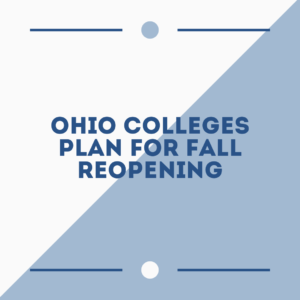The COVID-19 pandemic has caused uncertainty about how students will attend college in the fall. In particular, high school seniors are likely wondering how their academic and social lives will be impacted by changes in response to the pandemic. In March, Ohio campuses shut down, students attended classes online, and many residence halls closed to mitigate spread of the virus. Colleges across Ohio and the country are weighing the risks of bringing students back to campus. A small but growing number of Ohio colleges have announced that students will return for in-person instruction, while other institutions have not announced their plans. Many Ohioans and students across the country are carefully monitoring whether schools will be able to open just as quickly as they shut down.
The pandemic response has not only impacted current students, but also future students. In deciding if and where they will attend college, high school seniors will be weighing an institution’s plans for instruction in the fall. This year, universities have extended their enrollment deadlines by a month, pushing the date to June 1, with many contemplating an extension. This benefits the many students struggling to plan their post-secondary education. Ohio school leaders are weighing concerns that college-bound students are considering gap years or deferring their admission. Additionally, decisions about tuition may cause students to reconsider where they will attend school. With institutions charging full tuition for an altered learning experience, students may consider more cost-efficient higher education options such as attending community colleges. State spending cuts, student refunds, and volatile investment returns have cost Ohio’s 14 public universities roughly $300 million this fiscal year.
The Ohio State University is considering waiving the requirements for on-campus living and requiring mask-wearing while on campus. No final decisions have been made by universities regarding implementing these procedures. Physical distancing requirements also threaten college sports which are important revenue streams for many institutions. The University of Cincinnati suspended its men’s soccer program, Bowling Green cancelled its baseball season, and the University of Akron cut men’s cross country, men’s golf, and women’s tennis. College sports ticket sales bring in almost $60 million for The Ohio State University, serving as a significant revenue stream for the institution. Due to physical distancing requirements, it is likely institutions will be significantly economically impacted by these changes.
The Ohio State University’s Post-Pandemic Operations Task Force is planning ahead for two potential scenarios: online instruction for the entire fall semester and some form of in-person classes in the fall. In order for students to return to the classroom, universities must develop plans for sanitizing and physical distancing. Part of the college experience many students receive when attending a higher education institution is the introduction to a more diverse community than the one they come from. Students familiarize themselves with concepts of diversity and inclusion, allowing them to become more well-rounded individuals. Virtual learning does not allow for these same experiences.
It’s expected that more plans for Ohio’s colleges and universities will be announced over the summer.

